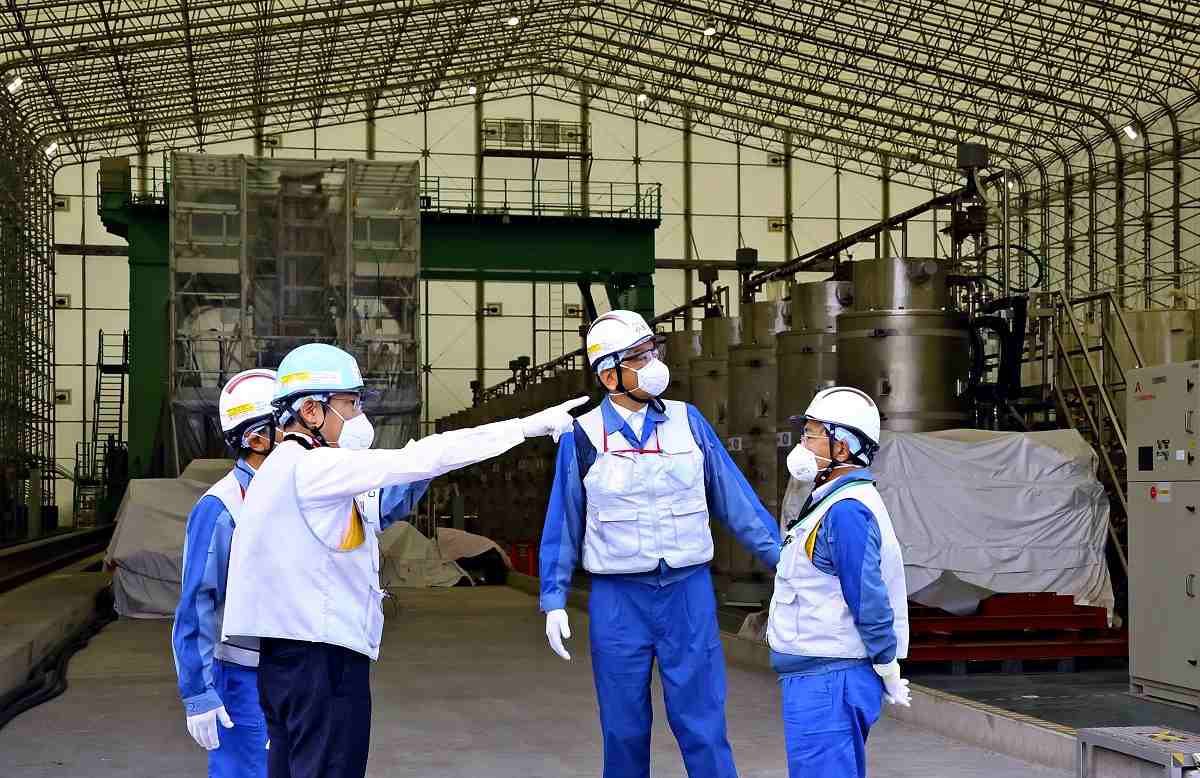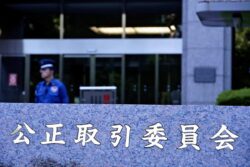Japan Prime Minister Focuses on Relieving Fears Over Water Release from Fukushima Plant

Prime Minister Fumio Kishida, left forefront, inspects the Advanced Liquid Processing System at the Fukushima No. 1 nuclear power plant on Sunday afternoon.
6:00 JST, August 22, 2023
Prime Minister Fumio Kishida has visited the Fukushima No. 1 nuclear power plant in an effort to dispel concerns over the government’s plan to begin releasing treated water from the plant into the ocean.
Kishida made the visit on Sunday despite having just returned from a three-day visit to the United States. He decided it was necessary for him to personally confirm the plan’s safety as soon as possible, ahead of the planned release later this month.
Arrangements for releasing the water are in their final stages, as acceptance of the plan is growing both at home and abroad.
Careful procedures
“The amount of water to be released per day will be strictly controlled, is that right?” Kishida asked executives of operator Tokyo Electric Power Company Holdings, Inc. as he inspected preparations for the release of the treated water.
Kishida was told about the capabilities of the Advanced Liquid Processing System, or ALPS, which treats the water accumulated at the power station, and he repeatedly asked questions from the standpoint of the general public.
“Looking at the years to come, the government and TEPCO must do their utmost, prepared and determined not to betray the trust of people both at home and abroad,” Kishida told TEPCO officials with a stern expression after inspecting the inside of the power plant.
The visit was set up at Kishida’s request. He reportedly told aides that he wanted TEPCO officials to once more stiffen their resolve.
The 2011 accident has eroded confidence in the company. If TEPCO fails to ensure safety after the treated water begins to be released, it will discredit both that company and the Japanese government.
Based on this concern, the prime minister cautioned TEPCO officials by repeatedly using such words as “determination” and “sense of crisis.”
On July 4, the International Atomic Energy Agency released a comprehensive report saying Japan’s water release plan is consistent with international safety standards.
In response to the IAEA’s “endorsement,” some within the government and ruling parties insisted that the treated water should be released without delay, according to an executive of the ruling Liberal Democratic Party.
Despite such calls, Kishida decided to carefully take his time and proceed step by step.
Countering misinformation
The government has especially focused on eliminating concern within the local fishing industry.
Even after the release of the IAEA report, Economy, Trade and Industry Minister Yasutoshi Nishimura and reconstruction minister Hiromichi Watanabe had a series of meetings with representatives of the fisheries industry. Nishimura and Watanabe explained that the treated water’s safety is being ensured on scientific grounds and the government is taking all possible measures to deal with misinformation.
The government set up a fund totaling about ¥80 billion, or about $550 million, by fiscal 2022 to help the fisheries industry in case it is impacted by misinformation. The fund will be used to cover costs for fisheries cooperatives and others to purchase fisheries products that can be frozen and preserved temporarily, as well as for finding new fishing grounds if fish and fisheries products caught off Fukushima Prefecture do not sell due to misinformation.
TEPCO is also ready to pay compensation if misinformation results in lower prices for fisheries products.
But more than a few members of the fisheries industry have voiced concern over harm caused by false rumors.
“A certain level of understanding has been achieved regarding the safety of treated water, but safety and a sense of security are different,” said Toshimitsu Konno, head of the Soma-Futaba fisheries cooperative association.
However, some fisheries officials have begun to show understanding for the government’s efforts, saying they “sense sincerity.”
International understanding
There is also growing understanding in the international community, which is providing a tailwind for the Japanese government.
The United States, France, Australia and many other countries have expressed support for the Japanese government’s plan. South Korean President Yoon Suk Yeol said Friday that he trusts the IAEA’s report.
China has spoken against the planned release without presenting scientific grounds for its opposition, but this stance has failed to draw wide support.
Opinion polls by media outlets also show that more people support the release plan than oppose it.
“Devoting a lot of time to gain public understanding has proved successful,” said a high-ranking government official. “We have to strive to provide careful explanations to the public, with the prime minster at the forefront of these efforts.”
"Politics" POPULAR ARTICLE
-

Japan to Support Central Asian Logistics Route That Bypasses Russia, Plan to Be Part of Upcoming Summit in Tokyo
-

Japan to Tighten Screening of Foreigners’ Residential Status by Providing Information of Nonpayment of Taxes
-

Chinese, Russian Bombers Flew Unusual Path by Heading Toward Tokyo; Move Likely Meant to Intimidate Japan
-

Japan Plans National Database to Track Foreign Ownership of Real Estate, Land as It Weighs New Rules
-

Up to 199,000 Deaths Estimated From Mega-Tsunami; Most Recent Occurrence Took Place in 17th Century
JN ACCESS RANKING
-

Tokyo Economic Security Forum to Hold Inaugural Meeting Amid Tense Global Environment
-

Keidanren Chairman Yoshinobu Tsutsui Visits Kashiwazaki-Kariwa Nuclear Power Plant; Inspects New Emergency Safety System
-

Imports of Rare Earths from China Facing Delays, May Be Caused by Deterioration of Japan-China Relations
-

University of Tokyo Professor Discusses Japanese Economic Security in Interview Ahead of Forum
-

Japan Pulls out of Vietnam Nuclear Project, Complicating Hanoi’s Power Plans



-250x167.jpg)






















